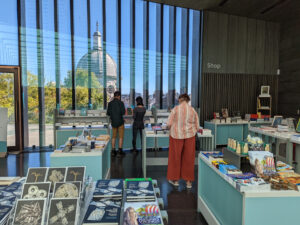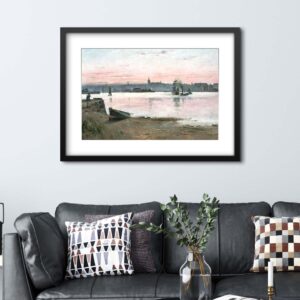Museum Retail at ‘Shop at the Top’
Matthew Williams, Commercial Development Manager for Aberdeen Archives, Gallery and Museums at Aberdeen City Council, explains how Aberdeen Art Gallery overcame structural challenges in their redesigned building to create a new museum shop supporting local creative makers.

Overview
After a five-year redevelopment, Aberdeen Art Gallery reopened in November 2019. Only to close again four months later due to the COVID pandemic. The building won awards, but the architecture made our retail offering more challenging.
During lockdown, our Retail Manager, Susy Bell, thought about how to address our issues. How can we meet customer needs when our building layout limits our floor space and product display?
Creative makers and local products
Susy singled out an empty space on the gallery’s top floor. She came up with the idea of ‘Shop at the Top’. A curated programme of five local artists and makers changing every three months or so. Susy chose the first artists and makers. From then on, each cohort nominated those who would take their place, “pay it forward” style. Susy brought it all together on a shoestring budget. We spent most of the budget on retail cubes to display makers products in the best possible light.
The program focused on supporting local makers instead of making money. Its popularity proved that the top floor gallery shop concept could succeed. The sales point was also convenient for visitors buying tickets to paid exhibitions in the temporary galleries next door.
When I started working for the Gallery, I realised the Shop at the Top had more potential. I found a grant from the Scottish Government’s City Centre Recovery Fund. They gave us £32,000 for shop fittings. Susy and I planned for displays that go well with the beautiful top floor architecture of the Gallery. We needed the fitout to be modular, colourful, and flexible for different events and exhibitions. It needs lots of flat surfaces for distinct types of products and visual merchandising styles.
Building on potential
The expanded space is now used for local makers work and for books aimed at visitors and local creatives. The mix of products in different price ranges makes the space profitable as it has options for all visitors. Adding books to the Shop at the Top has made more room in the ground floor shop. The range of books is still the same.
The new fitout also works brilliantly for temporary exhibitions. For this year’s “A Quentin Blake Summer” the entire space was Quentin Blake books and products. During the exhibition, the Shop at the Top did 33% better than the ground floor retail space. Sales were up 248% on the previous year. We made this 10-week change to take advantage of the commercial opportunity. But we also felt that mixing lots of young families with delicate artwork wouldn’t be a good idea!
Aberdeen Art Gallery also has maker markets from Tea Green Events, a well-known creative pop-up in Scotland. Joanne MacFadyen curates the markets with Susy and her team. We added another market to the Shop at the Top when Quentin Blake was on. This was to make sure that makers were still a big part of our retail offer.

The challenges of online retail
Since I joined the team, I’ve focused on in-store retail, so we don’t yet have an online shop. Instead print-on-demand products are available through our partners Art UK.
In my past jobs, I’ve learned that running an online store takes a lot of resources to make money. Customer expectations for online shopping are high. They want fast shipping and low delivery costs. To start a successful online shop, you need to spend time designing, taking photos, writing descriptions, and improving search engine optimisation (SEO). You need staff to pick, pack and dispatch items. If you can’t do this from a separate space, both in-person and online customers will end up frustrated. In-person customers may have their needs ignored and packaging may spill onto the shopfloor. Online customers may experience slower delivery times.
This is particularly acute in the run-up to Christmas when online and in-store sales peak at the same time. As we work on our online retail plan, we’ve used Art UK’s online shop facilities. Susy’s limited staff resources are used on the more profitable in-person experience for visitors. We focus on providing excellent service and telling stories through our products. We also create attractive displays and develop new product lines.
Shop at the Top stands out because it sells products made by local creatives. It supports the local creative industry and artists who may feature in our gallery in the future. It’s loved by our customers, supports the mission of Aberdeen Art Gallery, and is a highlight for our retail team. Susy is working on our next selection of makers in time for Museum Shop Sunday this year, on 26th November, and the coming festive season.
Key takeaways
- You need to know what will be appealing to your visitors in order to stock your shop. Any audience research you can do will help a lot.
- It’s helpful to experiment with a small idea or inexpensive stock before committing more money.
- A museum shop can be community focused and support local creatives.
- Online retail uses a lot of staff time to do well and may have smaller profit margins
- Third party retail opportunities are a great way to have an online offering that is less risk and resource intensive.